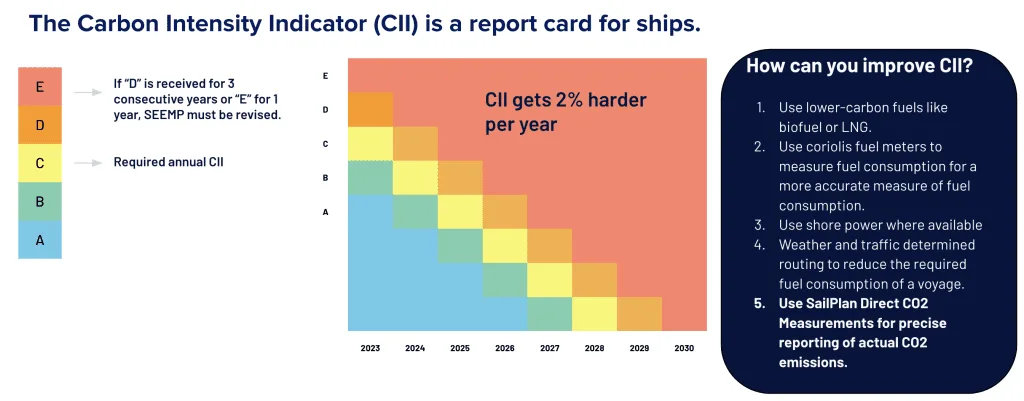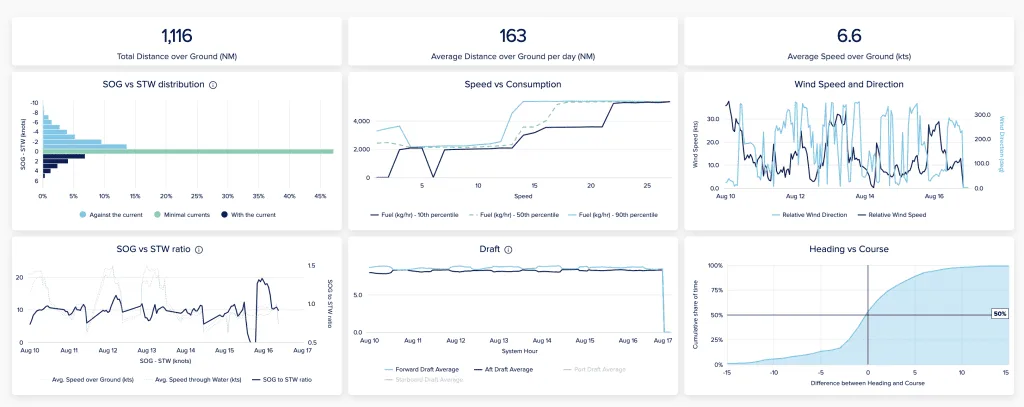In the maritime industry, the challenge of maintaining compliance with environmental regulations while optimizing operational efficiency is ever-present. One key metric that helps strike this balance is the Carbon Intensity Indicator (CII). SailPlan’s advanced technology provides accurate, real-time emissions data, enabling operators to effectively improve their CII ratings.
What is the Carbon Intensity Indicator (CII)?

The CII is a measure established by the International Maritime Organization (IMO) to gauge the efficiency of a vessel in terms of CO2 emissions per cargo-carrying capacity and nautical mile. This metric, mandatory under MARPOL Annex VI, applies to all vessels over 5,000 GT that operate internationally. Starting in 2024, vessels will be rated annually on a scale from A (major superior) to E (inferior performance) based on their operational carbon intensity. Vessels rated D or E for three consecutive years must submit a corrective action plan to elevate their rating to at least a C level.
Why Monitoring CII Matters
Monitoring CII is not merely about regulatory compliance; it carries significant operational and financial implications. A lower CII rating signifies higher fuel efficiency, translating directly into cost savings. Accurate CII monitoring enables operators to optimize fuel consumption, reduce operational costs, and enhance overall vessel performance. Conversely, inaccurate CII monitoring can lead to poor ratings, resulting in higher fuel costs, increased emissions, and potential penalties. The financial burden of non-compliance, coupled with reputational damage, can severely impact a company’s bottom line. Effective CII monitoring ensures that vessels remain competitive and environmentally responsible.
Many of our customers have indicated that poor CII ratings are costing them millions in biofuel spend. SailPlan can help reduce these costs instantly.

Outdated Methods: Inefficient and Costly
Traditional methods of CII reporting are often outdated, slow, and labor-intensive, involving numerous personnel for data collection and analysis. These manual processes can lead to errors and delays, resulting in inefficiencies and increased costs. The reliance on paper logs, manual entries, and delayed data processing means that operators often lack the real-time insights necessary for timely decision-making. This can result in missed opportunities for optimization and heightened operational costs. In contrast, SailPlan’s automated system provides real-time, precise data, reducing the need for extensive manual input and the risk of human error. By streamlining data collection and analysis, SailPlan minimizes operational costs and enhances efficiency, allowing operators to focus on strategic decision-making rather than time-consuming data management.
How SailPlan Helps Improve CII Ratings
- Direct Emissions Measurement:
SailPlan provides an immediate improvement to CII by monitoring direct exhaust CO2 emissions. If you are using some amount of HVO or biofuels as a part of your strategy to achieve a target CII score, SailPlan will help you accurately calculate the HVO and biofuel amounts needed, resulting in better fleet-wide cost management of these expensive fuels.
Before using SailPlan, many of our customers inadvertently reported higher CO2 emissions, leading to less accurate decisions on fuel choices and operational planning. This also affected the daily execution of voyages. By using SailPlan, you will have access to accurate data, enabling informed operational decisions, reduced fuel costs, and a faster, easier way to enhance your CII rating.

- Optimizing Fuel Efficiency:
Fuel consumption significantly impacts a vessel’s CII rating. SailPlan’s performance monitoring system continuously analyzes fuel usage and identifies inefficiencies. Operators can use this data to optimize sailing speeds, adjust routes, and ensure the vessel operates at its most efficient capacity, reducing fuel consumption and emissions.


- Comprehensive Compliance Support:
SailPlan’s platform provides necessary data for IMO DCS and EU MRV reporting, facilitating the aggregation and verification of emissions data. This seamless integration ensures all required data is accurately reported, helping vessels maintain compliance and avoid penalties.
Conclusion
Improving a vessel’s CII rating is crucial for compliance and operational efficiency in the maritime industry. SailPlan’s advanced emissions monitoring and performance optimization technology provides the necessary tools to achieve better CII scores. By leveraging real-time data and predictive analytics, operators can enhance fuel efficiency, perform proactive maintenance, optimize routing, and ensure compliance with international regulations. For more information on how SailPlan can improve your vessel’s CII rating, reach out to our team today. Together, we can navigate towards a more sustainable and efficient maritime industry.


